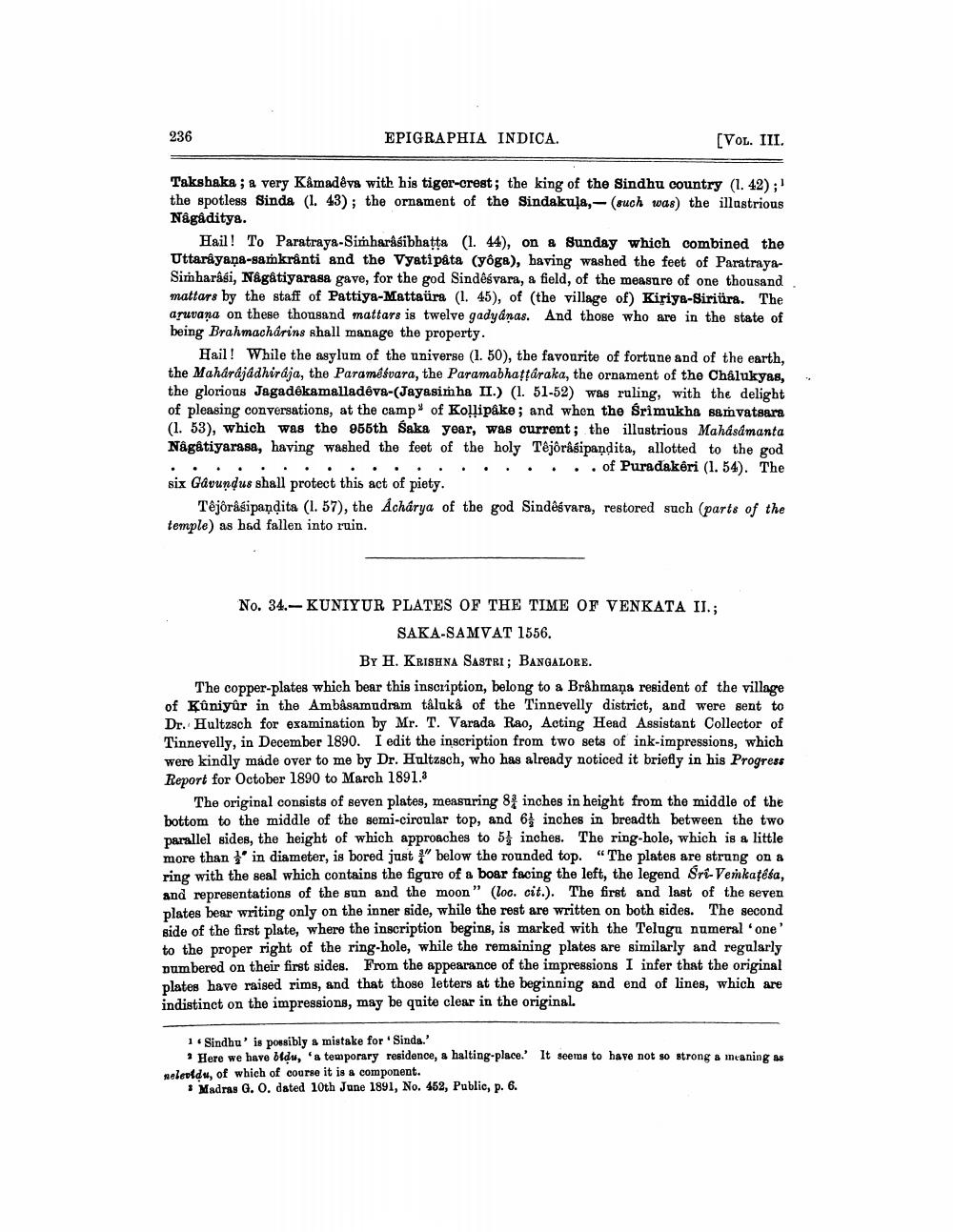________________
236
EPIGRAPHIA INDICA.
[VOL. III.
Takshaka ; & very Kamadeva with his tiger-crest; the king of the Sindhu country (1.42);! the spotless Sinda (1. 43); the ornament of the Sindakula,- (such was) the illastrious Nâgâditya.
Hail! To Paratraya-Simharàsibhatta (1.44), on & Sunday which combined the Uttarayaņa-samkranti and the Vyati påta (yôga), having washed the feet of ParatrayaSimharasi, Någåtiyarasa gave, for the god Sindêsvara, a field, of the measure of one thousand mattars by the staff of Pattiya-Mattaüra (1. 45), of (the village of) Kiriya-Siriüra. The aruvana on these thousand mattars is twelve gadyanas. And those who are in the state of being Brahmachårins shall manage the property.
Hail! While the asylum of the universe (1. 50), the favourite of fortune and of the earth, the Maharajadhiraja, the Paramétvara, the Paramabhattâraka, the ornament of the Chalukyas, the glorious Jagadēkamalladêva-(Jayasinha II.) (1. 51-52) was ruling, with the delight of pleasing conversations, at the camp of Kollipake; and when the Srimukha samvatsara (1. 53), which was the 55th Saka year, was current; the illustrious Mahasamanta Någåtiyarasa, having washed the feet of the holy Têjóråsipandita, allotted to the god . . . . . . . . . . . . . . . . . . . of Puradakêri (1. 54). The six Gavundus shall protect this act of piety.
Têjórasipandita (1. 57), the Acharya of the god Sindesvara, restored such (parts of the temple) as had fallen into ruin.
No. 34.- KUNIYUR PLATES OF THE TIME OF VENKATA II.;
SAKA-SAMVAT 1556.
BY H. KRISHNA SASTRI; BANGALORE. The copper-plates which bear this inscription, belong to a Brâhmaņa resident of the village of Kûniyûr in the Ambasamudram tâluků of the Tinnevelly district, and were sent to Dr. Hultzsch for examination by Mr. T. Varada Rao, Acting Head Assistant Collector of Tinnevelly, in December 1890. I edit the inscription from two sets of ink-impressions, which were kindly made over to me by Dr. Hultzsch, who has already noticed it briefly in his Progress Report for October 1890 to March 1891.3
The original consists of seven plates, measuring 84 inches in height from the middle of the bottom to the middle of the semi-circular top, and 6 inches in breadth between the two parallel sides, the height of which approaches to 51 inches. The ring-hole, which is a little more than in diameter, is bored just 1" below the rounded top. "The plates are strong on a ring with the seal which contains the figure of a boar facing the left, the legend Sri Venkatesa, and representations of the sun and the moon" (loc. cit.). The first and last of the seven plates bear writing only on the inner side, while the rest are written on both sides. The second side of the first plate, where the inscription begins, is marked with the Telugu numeral 'one' to the proper right of the ring-hole, while the remaining plates are similarly and regularly numbered on their first sides. From the appearance of the impressions I infer that the original plates have raised rims, and that those letters at the beginning and end of lines, which are indistinct on the impressions, may be quite clear in the original.
It seems to have not so strong & meaning as
1 Sindhu' is possibly a mistake for Sinda.'
Here we have oldu, 'a temporary residence, a halting-place. nelevidu, of which of course it is a component.
* Madras G. O. dated 10th June 1891, No. 452, Public, p. 6.




